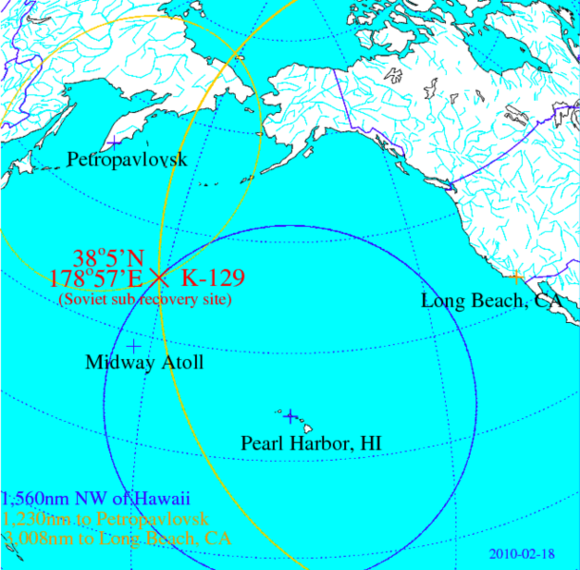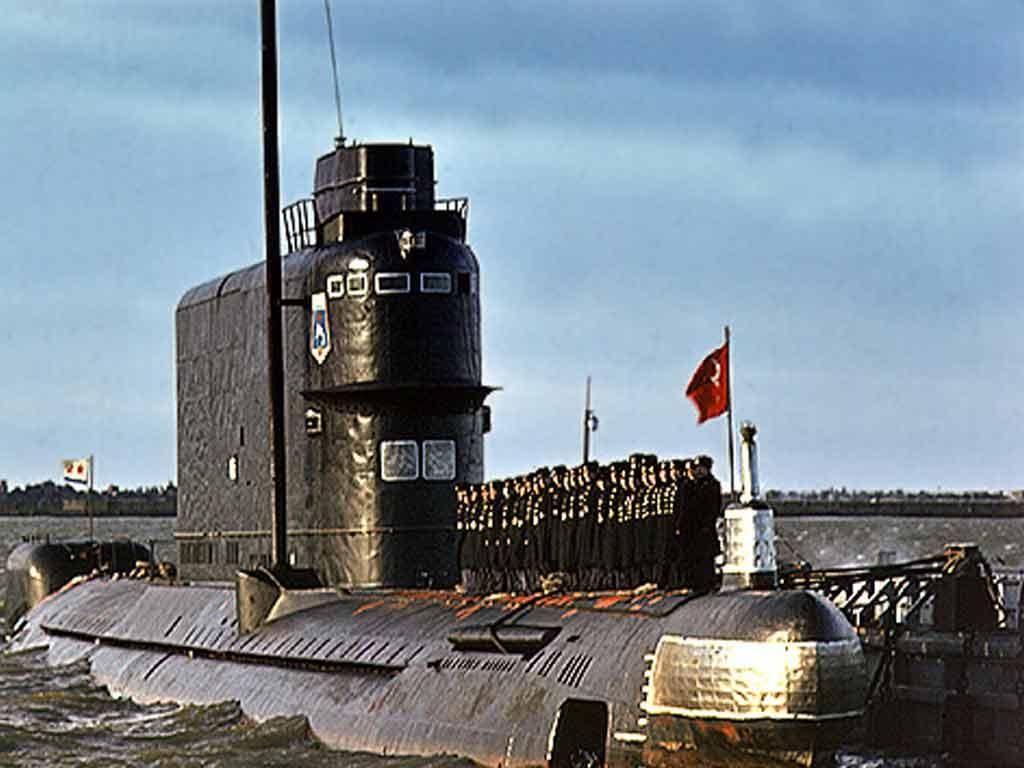| Golf-class submarine
高尔夫级(629型)常规弹道导弹潜艇 Date:2016-08-09 Source:wikipedia By:Globalmil Viewed: |
Project 629, also known by the NATO reporting name of Golf class, were diesel electric ballistic missile submarines of the Soviet Navy. They were designed after six Zulu class submarines and were successfully modified to carry and launch Scud missiles. All Golf boats had left Soviet service by 1990. All have been since disposed of.According to some sources at least one Golf-class submarine is operated by China, to test new SLBMs.
629型,也被北约报告称为高尔夫级,是苏联海军的柴电弹道导弹潜艇。它们在建造六艘祖鲁级潜艇之后被设计并成功改装用于携带和发射飞毛腿导弹。苏联所有的高尔夫级潜艇到1990年已经全部退役,一直以来这样处置。据一些消息来源至少有一艘629型潜艇是由中国操作,去测试新的潜射弹道导弹。
Class history
高尔夫级历史
Project 629 was started in the mid-1950s along with the D-2 missile system which it was to carry, and was based on the Foxtrot. Design task was assigned to OKB-16, one of the two predecessors (the other being SKB-143) of the famous Malachite Central Design Bureau, which would eventually become one of the three Soviet/Russian submarine design centers, along with Rubin Design Bureau and Lazurit Central Design Bureau ("Lazurit" is the Russian word for lazurite). The submarine was originally designed to carry three R-11FM ballistic missiles with a range of around 150 km. These were carried in three silos fitted in the rear of the large sail behind the bridge. They could only be fired with the submarine surfaced and the missile raised above the sail but the submarine could be underway at the time. Only the first three boats were equipped with these—the remaining ones were equipped with the longer range R-13 missiles.
629计划是在50年代中期与它携带的D-2导弹系统一起启动的,并且基于“狐步”级潜艇(北约代号:Foxtrot,641型)。设计任务被分配到第16特种设计局(OKB-16),著名的孔雀石中央设计局的两个前身之一(另一个是SKB-143),最终成为三个苏联/俄罗斯潜艇设计中心之一,连同红宝石设计局和孔雀石中央设计局(“Lazurit”是俄语孔雀石)。潜艇最初设计用来携带三枚R-11FM型弹道导弹,射程约150公里。这些在三个仓筒内携带安装在舰桥后部的大凸舱后部。它们仅能在潜艇浮出水面和导弹升到大凸舱顶部时发射,但该潜艇能够在行进中。只有前三艘潜艇装备了这些,其余的都配备了射程更远的R-13型导弹。
The first boats were commissioned in 1958 and the last in 1962.
第一潜艇在1958年被定制,最后一艘在1962年。
The boats were built at two shipyards — 16 in Severodvinsk and 7 in Komsomolsk-na-Amure in the Far East. Fourteen were extensively modified in 1966–1972 and became known as 629A's by the Soviet Navy and Golf IIs by NATO (the original version having been designated Golf I). The major change was the upgrade of the missile system to carry R-21 missiles which could be launched from inside their tubes with the submarine submerged and increased speed. In later years a few were converted to test new missiles and others had different conversions.
潜艇在两个船厂建造—16艘在北德文斯克和7艘在远东的阿穆尔共青城。十四艘在1966年–1972年广泛改装并被苏联海军称为629A型和北约称为高尔夫II型(最初版本已被命名为高尔夫I型)。主要的变化是对导弹系统升级用于携带R-21导弹可以从贮藏管内和潜水艇潜行时发射并且增加航速。在后来的几年中,一些被改装用于测试新的导弹和其他不同的改装。
All boats had left Soviet service by 1990. In 1993, ten were sold to North Korea for scrap.According to some sources, the North Koreans are attempting to get these boats back into service.
至1990年所有的潜艇都从前苏联退役。在1993年,十艘当作废料出售给北朝鲜。据一些消息人士称,北朝鲜试图把这些潜艇重新投入使用。
In 1959 the project technology was sold to China which built a single modified example in 1966, which is still in service.
在1959年,该项目技术销售给中国,在1966年建造了一艘改进型的例子,仍在服役中。
Project Azorian
Main article: Project Azorian
On March 8, 1968, 1,560 nautical miles (2,890 km) northwest of Oahu in the Pacific Ocean the Golf II class submarine K-129 exceeded its crush depth for unknown reasons and imploded, the accident being registered by the SOSUS network. The entire crew of 98 was lost and the vessel sank with three ballistic nuclear missiles as well as two nuclear torpedoes. The United States recovered parts of the submarine in July 1974 from a depth of around 5 km, in an operation named Project Azorian.
Azorian计划
主要文章:亚速尔人(Azorian)计划
1968年3月8日,距西太平洋瓦胡岛北方1560海里(2890公里)一艘高尔夫II级潜艇k-129号未知原因超出其下潜深度,爆炸,意外事故被水下声波监听系统 (SOSUS)网络记录。全体98名人员连同潜艇上的三枚弹道核导弹以及核鱼雷一块沉没。美国在1974年7月约5公里的深度回收潜艇的一部分,这个操作命名为亚速尔人(Azorian)计划。

Two nuclear submarines that had been facing retirement, USS Halibut (SSGN-587) and USS Seawolf (SSN-575), were rebuilt and pressed into service as deep sea search vehicles. After Halibut discovered a sunken Soviet submarine containing at least one intact ballistic missile complete with nuclear warhead, Melvin Laird, United States Secretary of Defense under President Richard Nixon, approved Azorian. Six years later, 350 nautical miles (648 km) north of the Hawaiian Leeward Islands, a mechanical claw descended 17,000 feet (5,200 m) to the bottom of the Pacific and, guided by computers on board the Glomar Explorer, clamped onto the mass of twisted, rusting steel and began slowly raising it to the surface. It is unknown for sure how successful the effort was, but the United States has admitted to recovering a portion of K-129, which included six bodies of Soviet sailors that were buried at sea with full honors.
两艘即将退役的核潜艇,USS大比目鱼号(SSGN-587)和USS海狼号(SSN-575),重建并暂时当作深海搜索运载器。大比目鱼发现沉没的苏联潜艇连同至少一枚完整的配备核弹头的弹道导弹后,梅尔文·莱尔德,理查德·尼克松总统时期的美国国防部长批准了亚速尔人(Azorian)计划。六年后,夏威夷背风群岛北部350海里(648公里),机械爪下潜到太平洋17000英尺(5200米)深海底,由 Glomar Explorer号上船载计算机引导,夹在整个扭曲,生锈的钢制艇身上开始缓慢上升到水面。工作的成功程度肯定的未知的,但美国已经承认回收k-129号一部分,包括六名葬身海底苏联水手遗体。
Variants
改型
Project 629: Original design received NATO reporting name: Golf I, with a total of 22 boats built between 1958 through 1962. Dimension are 98.4 m for length, 8.2 m for beam and 7.85 m for draft. Surfaced/submerged displacement are 2794 / 3553 tons respectively. Surfaced/submerged speed are 15 / 12.5 kn respectively. Project 629 is crewed by 80 men, and is equipped by either D-1 launching system for SS-N-1 or D-2 launching systems for SS-N-4 SLBMs.
629计划:最初设计获得北约代号:高尔夫I级,1958年至1962年总共建成了22艘。艇身98.4米长,艇宽8.2米和吃水线7.85米。水面/水下排水量分别为2794 /3553吨。水面/水下航速分别为15 / 12.5千米。629计划全体乘员80名,并且装备D-1发射系统用于SS-N-1潜射导弹或D-2发射系统用于SS-N-4型潜射导弹。
Project 629B: K-229 was converted in 1958 in Severodvinsk, under Project 629B to test newly designed on board missile control system, which was the first generation design fully based on semiconductors.
629B计划:1958年在北德文斯克K-229号被改装,在629B计划下,以测试新设计的舰载导弹控制系统,这是完全基于半导体的第一代设计。
Project 629A: 14 Project 629/Golf I class submarines were converted to Project 629A between 1966 thru 1972, and received NATO reporting name Golf II. Changes include the increase of dimension, with length and draft increased to 98.9 / 8.5 m respectively, the surfaced/submerged displaced increased to 2300-2820 / 2700-3553 t respectively, surfaced/submerged speed increased to 17 / 14 kn respectively. Crew is increased to 83, and the launching system is D-4 for SS-N-5 SLBMs.
629A计划:从1966年至1972年14艘629计划 /高尔夫I级潜艇被改装成项目629A,并得到北约代号高尔夫II。变化包括增加尺寸,长度和吃水线分别增加到98.9 / 8.5米,水面/水下排水量分别上升到2300至2820吨/ 2700-3553吨,水面/水下航速分别提高到17/14节。船员增加至83名,并且发射系统是D-4型用于SS-N-5型潜射导弹。
Project 601: K-118 was converted from 1969 thru 1974 and received NATO reporting name Golf III, with displacement increased to 4000 tons and number of SLBMs increased to 6, and the missile is SS-N-8.
601计划:K-118从1969年至1974年改装,并获得北约代号高尔夫III,排水量增加至4000吨,潜射弹道导弹的数量增加到6枚,导弹是SS-N-8型。
Project 605: K-102 was converted from 1969 thru 1973 and received NATO reporting name Golf IV, lengthened 18.3 m with 4 SLBMs to test R-27K (SS-N-13) SLBM.
605计划:K-102从1969年至1973年改装获得北约代号高尔夫IV,加长18.3米连同4枚潜射弹道导弹,用于测试R-27K型(SS-N-13)潜射弹道导弹。
Project 619: K-153 was converted in 1976 to test SS-N-20 SLBM, and received NATO reporting name Golf V.
619计划:K-153在1976年改装去测试SS-N-20潜射弹道导弹,并得到北约代号高尔夫V。
Project 629R: "K-61", "B-42" and "K-107" were converted in Vladivostok into command posts between 1973 - 1979, with the missile and torpedo tubes removed, received NATO reporting name Golf SSQ.
629R计划:“K-61”,“B-42”和“K-107”在1973年 - 1979年在符拉迪沃斯托克改装成指挥型,在拆除导弹和鱼雷发射管后,接受北约代号高尔夫SSQ。
Type 6631: Chinese built Golf-class submarine built in Dalian between 1960 thru 1966, after receiving technical data from USSR in 1959. China did not purchase SLBM, and thus Type 6631 was equipped with simulation systems and mainly used for training. Originally with pennant number 1101, it was subsequently changed to 200 in 1967. The second unit was supposed to be built and delivered by USSR (pennant number K-208), but due to Sino-Soviet split, most on board equipment was not delivered, and the boat was used as sample for reverse engineering to complete the first unit, which entered Chinese service in August 1966. In June 1968, Type 6631 went through a major refit because China decided to adopt solid fueled SLBM instead of liquid fueled SLBM Soviet used, so the simulation equipment was replaced by support equipment of solid fueled SLBM. In addition, the planned Chinese SLBM had different dimension than the original Russian SLBM equipped Golf class submarine, so the number of missile tubes were reduced to two from the original three.
6631计划:1960年至1966年中国在大连建造了629型潜艇,在1959年中国从苏联获得技术数据后,没有购买潜射弹道导弹,因此6631型配备了模拟系统,主要用于培训。最初舷号1101,它后来在1967年改为200号,第二艘本来要被苏联(弦号K-208)建造和交付,但由于中苏关系破裂,大部分潜艇上的设备未送达,并用船作为样本进行逆向工程完成第一单元,它于1966年8月进入中国服役。1968年6月,6631型通过重大改装,因为中国决定采用固体燃料潜射弹道导弹,而不是苏联使用的液体燃料潜射弹道导弹,所以模拟设备是由支持设备的替代燃料固体SLBM。此外,规划中的中国潜射弹道导弹已经比原来的俄罗斯潜射弹道导弹装备629型潜艇不同的尺寸,因此导弹发射管的数量从原来的三个减少到两个。

Type 031: Type 6631 went through a second major refit which was completed in November 1978. The most important improvement is the ability to launch SLBM underwater. In addition to changing to Type 031 from the original Type 6631, the unit also received the name Great Wall, when China began restore the practice to name its warships in the 1980s. The unit is hence usually referred as Great Wall 200.
031型:6631型,通过它在1978年11月最重要的改进完成了第二个主要的改装是潜射弹道导弹水下发射能力。除了从原来的6631型更改到031型,单位也收到命名长城,当中国开始恢复惯常来命名它在20世纪80年代的战舰。该单位通常因而被称为长城200。
Golf II class submarine
高尔夫II级潜艇
Class overview
该级概述
Operators:
Soviet Navy
Korean People's Navy
People's Liberation Army Navy
Preceded by: Zulu V class
Succeeded by: Hotel class
In service: 1958–1990
Completed: 24
操作范围:
苏联海军
朝鲜人民军海军
中国人民解放军海军
前任:祖鲁V级
后续:旅馆级(Hotel)
服役:1958-1990
完成:24艘
General characteristics
一般特性
Displacement:
2,794 tons surfaced/3,553 tons submerged (629)
2,300-2,820 tons surfaced/2,700-3,553 tons submerged (629A)
一般特性
排水量:
水面上2794吨/水下3553吨(629型)
水面上2,300-2,820吨/水下2,700-3,553吨(629A型)
Length:
98.4 m (323 ft) (629)
98.9 m (629A)
Beam: 8.2 m (27 ft)
艇长:
98.4米(323英尺)(629型)
98.9米(629A型)
艇宽:8.2米(27英尺)
Draught:
7.85 m (25.8 ft) (629)
8.5 m (629A)
吃水深度:
7.85米(25.8英尺)(629型)
8.5米(629A型)
Propulsion: 3 × diesel engines, each 2,000 bhp (1,500 kW); 3 × electric motors, 5,200 shp (3,880 kW); 3 shafts.
Speed: surface - 17 kn, 9.500 nmi/5 kn; submerged - 12kn
Range: 70 days endurance
Test depth:
260 m (design)
300 m (maximum)
Complement:
80 (629)
83 (629A)
推进:3×柴油发动机,每台2000马力(1500千瓦); 3×电动机,5200马力(3,880千瓦); 3轴。
航速:水面 - 17节,9.500海里/ 5节;潜航 - 12节
航程:70天耐力
测试潜深:
260米(设计)
300米(最大值)
配备人员:
80名(629型)
83名(629A型)
Armament:
3 × missile tubes
3 × Project 629 boats D-1 launch system with R-11FM missiles
Remaining boats D-2 launch system with R-13 missiles
1966 onwards 629A upgrade D-4 launch system with R-21 missiles
6 × 533 mm torpedo tubes
武器:
3×导弹发射管
3×629计划D-1发射系统与R-11FM导弹
其余的潜艇D-2发射系统与R-13导弹
1966年起629A型升级D-4发射系统与R-21导弹
6×533毫米鱼雷发射管
上一篇:没有了 下一篇:Type 032 submarine
| Type 032 submarine
中国海军032型实验潜艇 |
| The Type 032 submarine (NATO reporting name: Qing-class) is a class of diesel-electric submarine currently undergoing testing in China's People's Liberation Army Navy.... [2016-08-09] |
| Golf-class submarine
高尔夫级(629型)常规弹道导弹潜艇 |
| Project 629, also known by the NATO reporting name of Golf class, were diesel electric ballistic missile submarines of the Soviet Navy.... [2016-08-09] |

